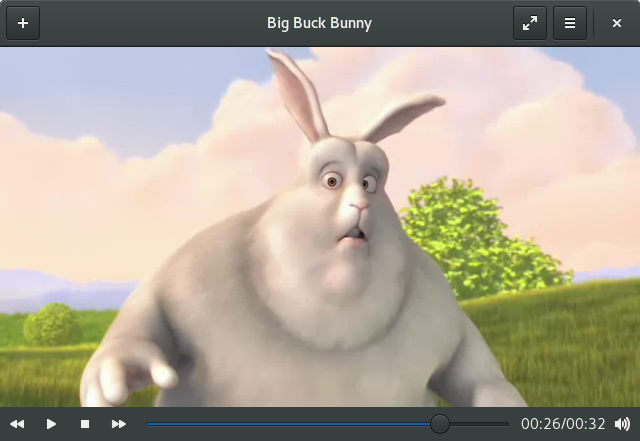GNOME MPV is a simple GTK+ frontend for mpv. GNOME MPV interacts with mpv via the client API exported by libmpv, allowing access to mpv's powerful playback capabilities.
- appstream-glib[1] (build)
- autoconf >= 2.69[1] (build)
- autoconf-archive[1] (build)
- automake >= 1.12[1] (build)
- python2[1] (build)
- pkg-config (build)
- gcc (build)
- glib >= 2.44
- gtk >= 3.18[2]
- mpv >= 0.21
- epoxy
- lua (optional)
- youtube-dl (optional)
[1]: Not required when building from release tarballs
[2]: Some features may be unavailable with gtk < 3.20
- Arch Linux: https://aur.archlinux.org/packages/gnome-mpv
- Arch Linux (Git): https://aur.archlinux.org/packages/gnome-mpv-git
- Debian testing: https://packages.debian.org/testing/gnome-mpv
- Debian unstable: https://packages.debian.org/sid/gnome-mpv
- Fedora (rpmfusion): https://admin.rpmfusion.org/pkgdb/package/free/gnome-mpv/
- Frugalware: http://www4.frugalware.org/pub/linux/distributions/frugalware/frugalware-current/source/xapps-extra/gnome-mpv/
- OpenSUSE: https://build.opensuse.org/package/show/home:mermoldy:multimedia/gnome-mpv
- Gentoo: http://gpo.zugaina.org/media-video/gnome-mpv
- Solus: https://packages.solus-project.com/shannon/g/gnome-mpv/
- Ubuntu: https://launchpad.net/~xuzhen666/+archive/ubuntu/gnome-mpv
To install with Guix, run the following command:
guix package -i gnome-mpvFlatpak builds can be obtained from https://dl.tingping.se/flatpak/. The build file is available in TingPing/flatpak-packages.
Run the commands below to install:
flatpak --user remote-add gnome https://sdk.gnome.org/gnome.flatpakrepo
flatpak --user install gnome org.gnome.Platform 3.22
flatpak --user remote-add tingping https://dl.tingping.se/flatpak/tingping.flatpakrepo
flatpak --user install tingping io.github.GnomeMpvRun the following command in the source code directory to build and install:
./autogen.sh && make && sudo make installAlternatively, you can use Meson:
meson build && cd build && ninja && sudo ninja installThere are 4 ways to open files in GNOME MPV.
- Passing files and/or URIs as command line arguments.
- Using the file chooser dialog box, accessible via the "Open" menu item.
- Typing URI into the "Open Location" dialog box, accessible via the menu item with the same name.
- Dragging and dropping files or URIs onto GNOME MPV.
The playlist is hidden by default. To show the playlist, click the "Playlist" menu item or press F9. Files can be added by dragging and dropping files or URIs onto the playlist. Dropping files or URIs onto the video area will replace the content of the playlist. Playlist files or online playlists (eg. YouTube's playlist) will be automatically expanded into individual items when loaded.
Items in the playlist can be reordered via drag-and-drop. To remove items from the playlist, select the item by clicking on it then press the delete button on your keyboard.
GNOME MPV can be configured using the preferences dialog accessible via the
"Preferences" menu item. Additional configuration options can be set from an
external file using the same syntax as mpv's mpv.conf. See mpv's man page for
the full list of options. The file must be specified and enabled in the
preferences dialog under the "MPV Configuration" section.
Options can also be set using the "Extra MPV Options" text box in the preferences dialog. The syntax used is the same as mpv's command line options.
GNOME MPV can use most mpv Lua scripts as-is. Some Lua scripts may define
keybindings that conflict with GNOME MPV, in which case you'll need to resolve
the conflict by explicitly defining new keybindings using input.conf. See
mpv's manual for
more details.
Lua scripts can be installed by switching to the Lua Scripts tab in the
preferences dialog and dropping script files there. A list of mpv Lua scripts
can be found
here.
GNOME MPV defines a set of keybindings in the macro DEFAULT_KEYBINDS, which
can be found in
src/def.h. The
syntax used is exactly the same as mpv's input.conf. These keybindings are
applied on top of default keybindings provided by mpv.
Additional keybindings can be defined in an external file using mpv's
input.conf syntax. The file can be set in the preferences dialog under the
"Keybindings" section.
GNOME MPV uses Zanata to coordinate translations. You can find GNOME MPV's page here. To start translating, follow the instructions here. If you'd like to add a new language, open an issue on GitHub.
While translating, you will find the string translator-credits. You should not
translate this string. Instead, you should put your name, and optionally your
email address, in the following format: FirstName LastName <Email Address>.
Your name will then appear in the About dialog when your translation is active.
GNOME MPV is free software: you can redistribute it and/or modify it under the terms of the GNU General Public License as published by the Free Software Foundation, either version 3 of the License, or (at your option) any later version.
GNOME MPV is distributed in the hope that it will be useful, but WITHOUT ANY WARRANTY; without even the implied warranty of MERCHANTABILITY or FITNESS FOR A PARTICULAR PURPOSE. See the GNU General Public License for more details.
You should have received a copy of the GNU General Public License along with GNOME MPV. If not, see http://www.gnu.org/licenses/.
